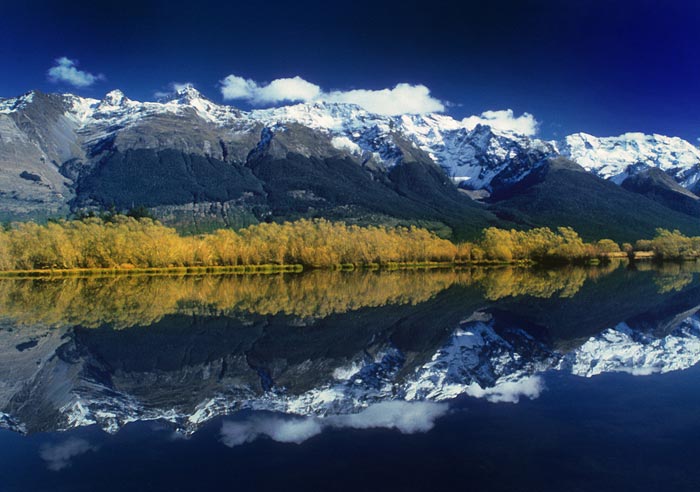
© Noella Ballenger. All Rights Reserved.
Glenorchy, New Zealand is a tiny town with spectacular scenery.
The morning I visited, the air was calm and the sky was brilliant. These were perfect
conditions for the magnificent vista and reflection of the mountains along the shore of Lake Wakatipu.
As a photographer for many years, I have developed what I call Life Themes. A Life Theme is a subject that you feel so comfortable photographing that you gravitate towards it naturally, or can use whenever you are feeling like you have “photographer’s block”, or can fall back on when your senses seem to be overloaded by the splendor of what you see. Life Themes are old friends that make you feel relaxed and secure in your photo subject wherever you are and then they joyfully send you on your way towards new adventures and new images.
Discovering your Life Themes comes after you have spent many hours photographing and even more hours studying your images. The basis of a Life Theme is in knowing what you instinctively like. When I began to work with my photographs, I sorted my images so that I would know what my visual biases were. Did I always photograph big skies? Was the color red prominent in most of my images? What subject kept cropping up no matter where I was? Did I favor strong lines in my images or perhaps circles? Did I do more street/city/people scenes or more trees, animals and nature scenes? Was I drawn to overall scenes or come in close to pick up the details? I worked at discovering what my comfort zones were photographically by making lists. Then I would summarize those lists. Suddenly it became very obvious that I had favorite subjects, frequent ways of composing an image and a definite color pallet to which I gravitated.
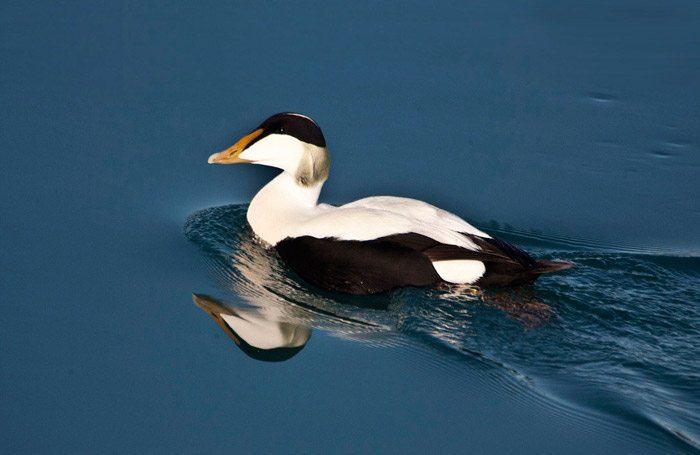
© Noella Ballenger. All Rights Reserved.
The male Eider Duck (where we get eider down feathers) is one of the most beautiful of all ducks in
mating plumage. Here he is paddling along in the Jokulsarlon Lagoon in the southeastern part of Iceland.
Once you discover what attracts you to a subject when you are photographing, then you have the beginnings to an awareness of your Life Themes. As you go forward, you know that you can always come back to these subjects or compositional keys and find a resting place for your mind. I’ve gotten into the habit of carrying a little notebook in my camera bag in which my Life Themes have been written. They are my comfort zones when my creativity hits a bumpy cross-country trail with what seems to be many dead ends, false clues and endless detours.
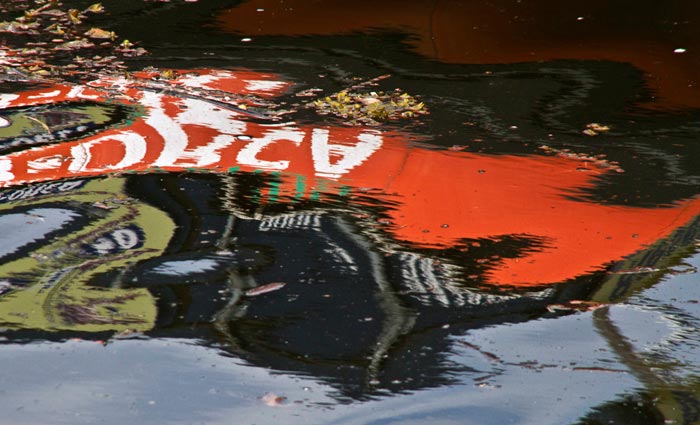
© Noella Ballenger. All Rights Reserved.
On one of my excursions, I stopped for breakfast at the commercial fishing harbor
in Port Townsend, WA. Reflections in the harbor can be stunning but you just have to look for them.
So what is “photographer’s block”? One of the more frustrating aspects of creativity is being mentally blocked and not knowing what to do or how to get yourself back on track. Writers call it “writer’s block”, but it happens in every field of artistry. It can occur when you’re tired, when you are trying to force yourself to try to do something new or different, or it can happen for what seems to be no reason at all.
When I find myself wandering about and not finding anything that looks interesting to photograph, I find that my creative mind has become dull and non-responsive. This is where having Life Themes comes in handy. I dig out my list, pick one and start to look around. Before I know it, I am back on an inspirational path and have moved away from my Life Theme subject and moved forward to discovering new points of interest to photograph. My Life Theme became a bridge that lifted me out of the pit of frustration and put me back on the creative track.
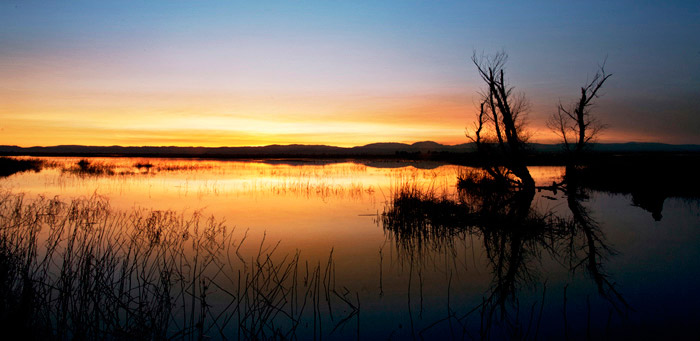
© Noella Ballenger. All Rights Reserved.
During the winter months, the sky and sunsets near the Sacramento Wildlife Preserve can be spectacular.
I have learned the hard way to wait until it is absolutely dark before leaving a sunset. There is nothing worse than seeing the sky flare brilliantly as you are driving away. And, frequently your camera can catch more in subtle tones and colors than the eye can see and especially in the reflections in a body of water.
Although I have a number of life themes, water is one of my favorites. There is something so soothing about water, even if it is rushing past you. You may just enjoy looking at it, or perhaps listening to it, but you may decide that you just have to capture it in images. It’s a magical playground for photographers. Whether it is a waterfall that you blur softly or a wave smashing against a rock where you catch the movement or a single drop or two that magnifies the surface that it sits on, it grabs your attention and can hold you enraptured. Water can be translucent or transparent or reflective. It can be so still that it becomes a mirror to the heavens or so wild that you can barely stop the movement. It is always changing. It is always challenging. It stays within my comfort area as any good Life Theme should.
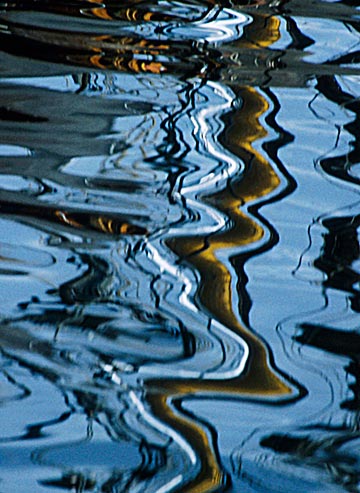
© Noella Ballenger. All Rights Reserved.
The small boat harbor in Los Angeles has very calm waters and I loved the way the reflections of the masts wiggled. Water takes many shapes and forms depending on the motion, the speed, and what is on the surface. Finding the patterns and squiggles is almost hypnotic.
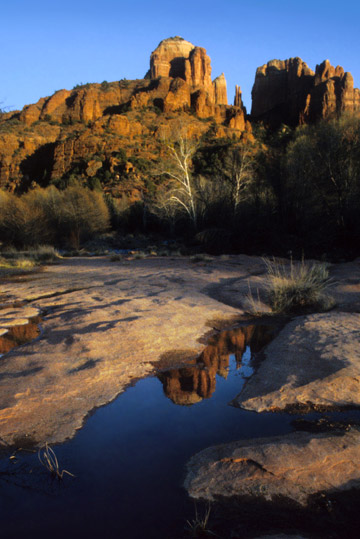
© Noella Ballenger. All Rights Reserved.
Even in the desert areas of Arizona near Sedona, you can find teacups of water that may reflect the lovely scenery. Whenever I see a water puddle, I always walk around to see if I can find a photogenic reflection.
One of the most common ways to photograph water is to capture the reflections that sit on its surface. There is something magical about mirror images. To get a great mirror image reflection, look for still water and light on the primary subject. Early morning and late afternoons are great for shooting reflections and I try to scout my locations and anticipate what it will look like at sunset or at sunrise. (Refer to lead photo.) If you have a half neutral density filter, you can tone down the sky half of the image and equalize the difference between the reflective surface and the scene. Your exposure will be better because the sky won’t wash out (over expose) and the water won’t go too dark (underexpose).
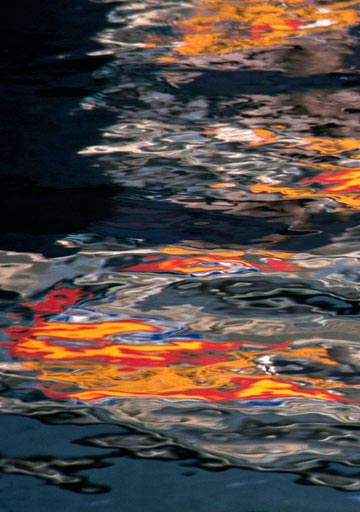
© Noella Ballenger. All Rights Reserved.
Walking along the dock area in Helsinki, Finland I saw the reflection of a beautiful church on the hill. The sun hitting the Church made the red-orange of the church bricks just glow. A slight ripple of wind and the reflection took life.
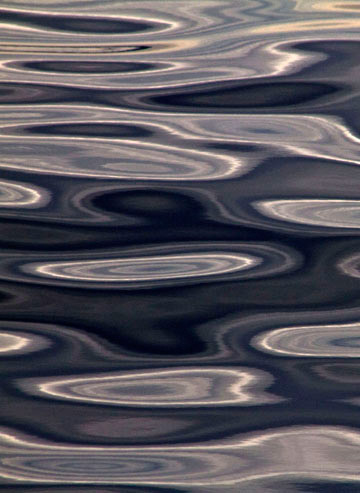
© Noella Ballenger. All Rights Reserved.
Slow wave ripples taken from a ferry going from Port Angeles, WA to Victoria, BC. We had stopped and were just waiting for a large ocean liner to move out of the channel. The water was very calm and the sky was overcast.
I love wildlife and the reflection of ducks as they paddle along a lake or a stream is so peaceful. Make sure your subject is in focus and that you have good depth of field (F-8 or smaller). Keep your shutter speed up to stop the action and then your bird and its reflection will be in focus. It’s always good to look for the direction from which the light is coming and the intensity of the light, because early or late light makes the feathers on the bird, along with its reflection, really pop.
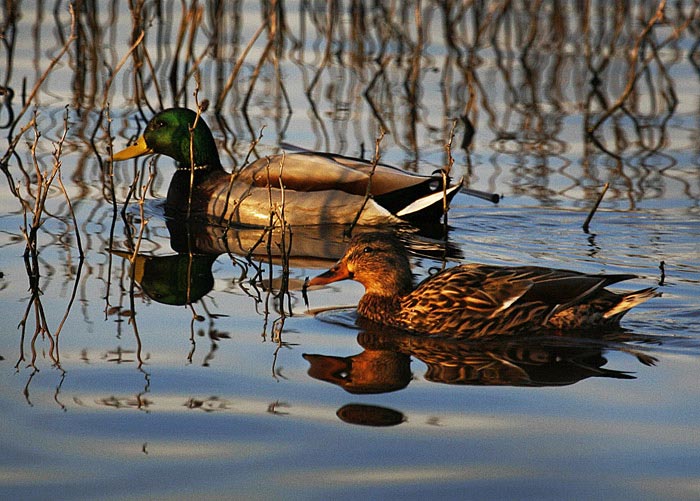
© Noella Ballenger. All Rights Reserved.
Mallard ducks (male and female) are drifting through the reeds in the Colusa National Wildlife Refuge
in Northern California. They are a common duck and the male has strikingly beautiful plumage.
Another popular way to photograph water is at a waterfall. We have all seen those wonderfully romantic, soft water waterfalls. To get really great shots, you need to have good depth of field (about F-8 or smaller) and a slow shutter speed (about 1/30 or slower depending on how fast the water is moving). You may need to adjust your ISO to get those settings and have to bracket and check to make sure you are getting just the right amount of softness.
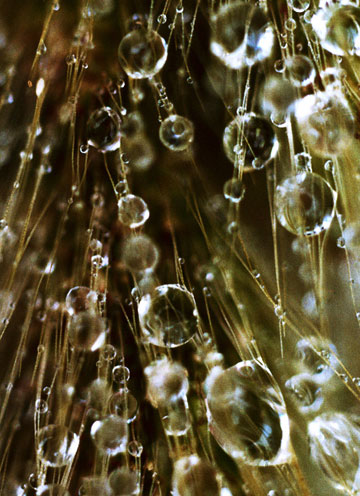
© Noella Ballenger. All Rights Reserved.
Weeds, like water, can be found worldwide and both are on my Life Themes list. When I combine them in one shot, I can’t miss. The weed here is the common foxtail. It was almost ready to fall over under the weight of a drenching rain. I had my macro lens and spent a long time photographing these bouncing balls of water.
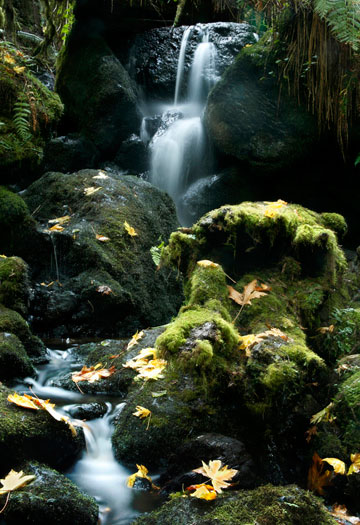
© Noella Ballenger. All Rights Reserved.
Hidden pockets of beauty can be found almost anywhere on earth and it is our job as photographers to make them special. Tiny Trillium Falls in the coast area of Northern California was a real treat…a true visual playground.
You can also freeze the action of water to make it look more exciting. Let’s say you are at the edge of a river or near the ocean and the water is fast and throwing up lots of spray as it bounces over rocks or comes ashore. Set your camera on shutter priority and anticipate where and when the splash will occur. Then blast away. Your shutter speed should probably be a minimum of 1/250 second to catch the moment. Then check and bracket until you have just what you like. If you have Continuous Shooting Mode on your camera, give it a try. You can be more assured of capturing the best moments of spray.
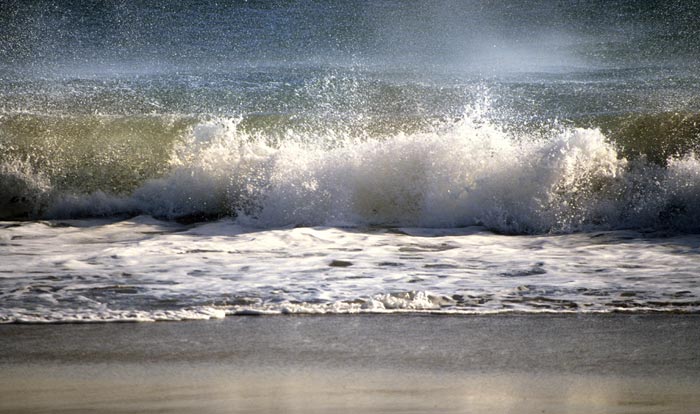
© Noella Ballenger. All Rights Reserved.
Oceans on stormy or windy days can be fascinating. I like using my long lens to capture
the spray, the foam along the shore and the reflection in the sand as the water retreats.
Just as the wave is rolling over it can become translucent and that is lovely too.
And then, some wonderful things happen when you see a drop of dew on a leaf or the reflection of a giant mountain in a small puddle. If you are in the city and it rains, grab the camera and go for it. Water makes the streets wet and shiny and the light reflections are dancing everywhere you turn.Nothing is more stimulating on a ho-hum indoor day than playing in water. Don’t forget to protect your camera with a plastic bag or camera rain jacket.
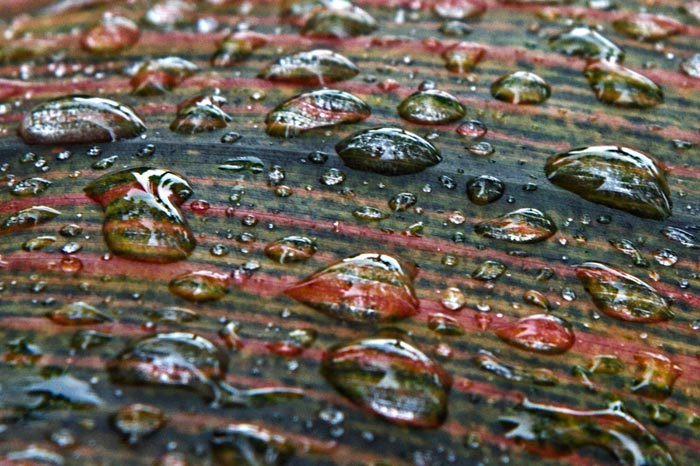
© Noella Ballenger. All Rights Reserved.
This was a beautiful tropical leaf that I found in a botanical garden. The colors were quite
striking, but following a soft rain, it was the tiny, sparkling drops of water that attracted me.
Thanks for coming with me as I explored one of my favorite Life Themes … WATER. Spend a few hours going through your past photographs and see if you can discover your own Life Themes. Then create your own list and take it with you as you go for a day of exploration. Working a Life Theme will wake up your senses and creative vision and spring board you into even more stunning photographs.
by Noella Ballenger

Leave a Reply